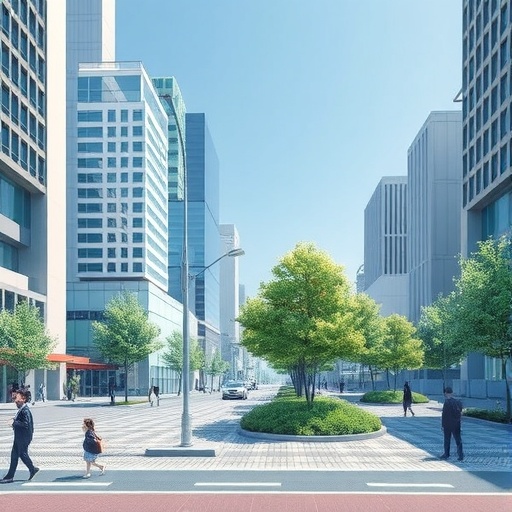In the fast-paced urban environment of Tokyo, where open space is a premium and the challenges of climate change loom large, innovative solutions are essential to reintegrate nature into city life. Vertical greening, a method that involves the integration of greenery on building façades, has emerged as a key strategy to mitigate urban heat and improve the overall aesthetic quality of densely populated neighborhoods. Until recently, however, the absence of a systematic methodology to identify the most effective locations for such greenery has hindered progress. A groundbreaking study led by researchers at Chiba University aims to change that.
This pioneering research provides a detailed spatial framework to analyze and assess the potential for vertical greening across Tokyo’s 23 wards. The findings, released online on September 6, 2025, and set to feature in the upcoming issue of the journal Sustainable Cities and Society, present an invaluable tool for urban planners and policymakers. For the very first time, a comprehensive map pinpointing existing vertical greenery in a city renowned for its high density is available, which can serve as a guide to enhance environmental quality.
The research team, headed by Professor Katsunori Furuya, utilized cutting-edge artificial intelligence techniques to analyze more than 80,000 images sourced from Google Street View. Employing a sophisticated deep-learning model known as YOLOv8, they meticulously identified vegetation displayed on building façades, including both green walls and balcony planters. This method enabled the researchers to construct a detailed inventory that illustrates the spatial distribution of vertical greening throughout Tokyo.
Professor Furuya states that their objective was to create clarity around the distribution of vertical greenery in dense urban settings, particularly in alignment or misalignment with the city’s environmental needs. The approach integrates various forms of spatial data with advanced image analysis to allow urban planners to identify areas where greening can have the most significant impact.
A significant development was the introduction of the vertical greening demand index (VGDI), a novel metric designed to assess where additional greenery could most effectively alleviate urban heat and bolster environmental quality. The VGDI incorporates an array of factors such as land use type, building density, surface temperature, and pedestrian exposure to heat, painting a complex picture of urban environmental dynamics.
The researchers’ findings indicate a stark inequality within the existing vertical greenery across Tokyo. While more affluent commercial and residential districts enjoyed the benefits of vegetative façades, numerous heat-prone areas, particularly in lower-income neighborhoods, were found to be lacking in greenery. This imbalance emphasizes the necessity for a more equitable approach to urban greening, ensuring that all city residents can benefit from the cooling and aesthetic advantages that greenery provides.
Of significant concern is the identification of “priority greening zones,” which the research highlighted as areas with profound potential for the introduction of vertical greenery. These are zones where the addition of vegetation can significantly reduce surface temperatures, thereby improving the thermal comfort of those who live and work there.
The conclusions reached in this study underscore that vertical greening is not merely an architectural enhancement; it is an essential component of urban environmental management. The implications of the research extend beyond Tokyo’s borders, offering a template for similarly compact cities grappling with rising temperatures and space constraints. Policymakers and urban planners can leverage tools such as the VGDI to inform building regulations, urban renewal strategies, and initiatives aimed at incentivizing greening efforts across communities.
In the long term, the integration of such data-driven approaches could drastically reshape urban landscapes, enabling cities to confront climate change proactively. As Professor Furuya articulates, the task of expanding greenery in existing urban environments stands as one of the most pressing challenges facing contemporary urban planning. He projects that over the next decade, the amalgamation of artificial intelligence with spatial analysis will empower governments and city designers to think strategically about developing greener, cooler, and more livable urban areas.
The research also draws attention to the particularly crucial elements of accessibility and fairness within urban environmental planning. Through the visual mapping of existing greenery and highlighting areas deficient in it, the framework serves as a tool for fostering more equitable decision-making. As urban centers worldwide strive toward sustainability, ensuring that the benefits of greening efforts are available to all residents—not just affluent communities—is vital for promoting overall urban resilience.
In summary, this study marks a significant stride in the intersection of artificial intelligence with urban ecology. Future objectives include refining the existing model to incorporate additional environmental parameters such as air quality and energy efficiency, while also adapting the framework for application in other megacities facing similar challenges related to urban heat. As the landscape of urban planning continues to evolve, the methodologies developed through this work will serve as a beneficial resource for cities looking to cultivate a more sustainable future.
Subject of Research: Urban Greening
Article Title: Development of a data-driven spatial framework for optimizing vertical greening in high-density Tokyo
News Publication Date: 15-Sep-2025
Web References: Sustainable Cities and Society
References: Not applicable
Image Credits: Professor Katsunori Furuya from Chiba University, Japan
Keywords
Urban Greening, Vertical Greening, Artificial Intelligence, Urban Heat, Climate Change, Environmental Quality, Tokyo, Green Walls, Urban Planning.




